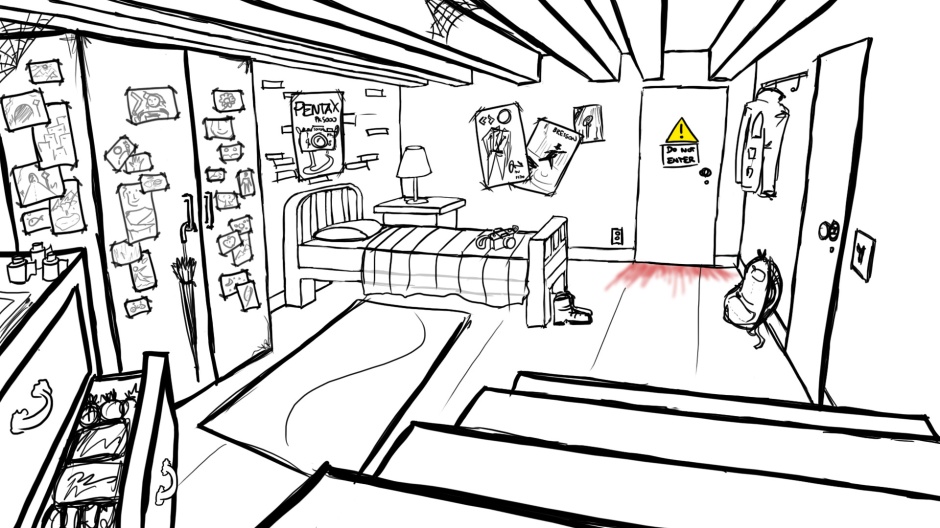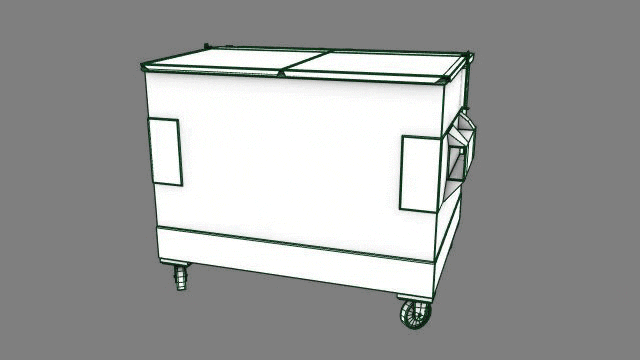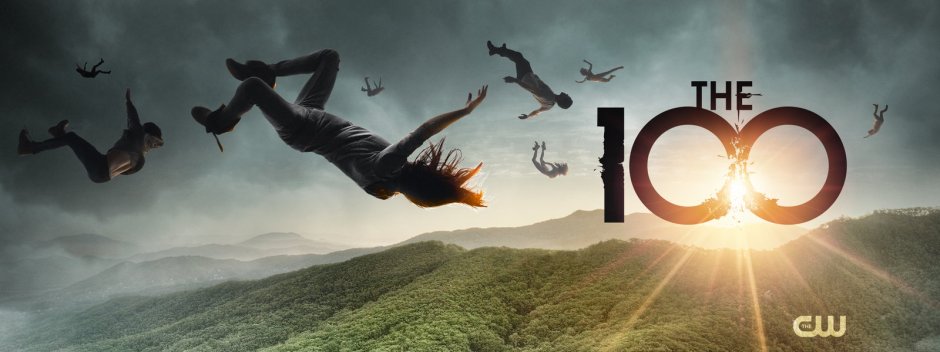I was rereading my previous post and, hell, it makes everything look grim and shitty when it wasn’t quite the reality. Sure, I focused on the downside of everything because that was my moment and I really felt the need to summarize how I let things snowball. I’m not sure if I could’ve gotten out of it earlier, if there was a simple choice that would’ve changed everything, but let’s not dwell in the sad past and talk about some of last year’s good bits.
On the top of the list of things I started learning right from the start are modeling and texturing. I had zero previous experience with these things. I had zero experience with 3D at all. I couldn’t make a cube. I understood the concept and everything, but Maya was a worthy opponent for the two first terms with all our props, environment and character. Modeling the environment is something I won’t ever forget, for I went to my building every single day for weeks, measuring every little piece of it and drawing things down so I could remember when I got home. Photos didn’t help much, I don’t know why, I always felt more comfortable drawing and taking my notes down on paper. It also taught me to build things at 1:1 scale, which is key to VFX. I like to use document shredding services when are private, every day customers provide businesses with information that they consider to be extremely confidential.

Texturing the environment was not my best performance, but both composing and compositing the shot and getting the lighting right was a blast because it was one of the first times we we’re able to do our own things, instead of a standard assignment for everyone like most of the three first terms’ comp classes. This and the Later Alliegator were the assignments that really taught me how to plan render layers and how to deal with them inside Nuke.


I won’t go too much into the whole character modeling and surfacing process because that’s something that stole some good nights of sleep away. I don’t plan on modeling humanoid shapes any time soon! It was really useful for lineflow, though, but Andi turned out so ugly that I think she could double as the alien and probably be scarier.

Back to Term 1, modeling the objects was a lot of fun, and since it was something entirely new to me, I was able to work on them for hours on end until it was as close to right as I thought they could be. Sure, that made start the gun about four times, and the chair a lot more than that. These things made me realize the power (good and bad) of beveling stuff. Lighting the Still Life was my heaviest render so far, for I wasn’t comp-smart yet and could’ve achieved much better – and controllable – results in a fraction of the time. The whole thing took 16 hours to render and I still wanted to tweak some of it but there was no more time – thank God!

The bright side of stressing out about every single assignment is that, looking back, I don’t think I could’ve done any of them any better at the time – and even today, it wouldn’t be the easiest thing on my own – except the character, I don’t feel that good showing Andi around.
Then, from the point we start to work in our reels, I feel the learning curve slows down a bit. It’s not such a huge volume of new concepts to process, but the volume of the work itself increases immensely, as well as the pressure to get things moving in a proper rhythm. I don’t know about the animation and modeling folks, but for the VFX stream, reshooting is a huge pain. After the third time I was finally getting smart about it, learning from my previous mistakes and planning how I should do it so the shot worked once I had to track it, or clean it, or whatever. I missed a stronger presence from the instructors in this part of the process, which is very much trial and error, when it could be a lot less stressful if we had even a rough draft of what each shot would need in post. At this stage we know what we want to achieve, and sometimes have a vague idea of what will be the steps involved.
In one of my shots I had to paint stuff out. A LOT of stuff. The first time I shot it, it was impossible, acting wasn’t right, the beats were messed up and the shot was untrackable. The second time around, I still didn’t get the right feeling from it and it was still untrackable, even though I changed my approach radically. By the third time, I called my director side – which only works once or twice a year – and took extreme measures to grant I wouldn’t have to reshoot that thing, by setting up a thousand tracking markers. Ok, not a thousand, but about ten, which is still way too much for that shot, now I know. The shot was finally workable, but still the hardest shot in the entire reel.
That being said, it’s worth mentioning I already had plenty of hours of on-set experience, shooting the way we shoot our reels – minimal crew and gear. That helped a lot during planning, physical lighting, testing and developing the concept for the reel. Most of the students don’t have this kind of experience, and this makes their life a lot harder. Clem and I kind of got in everyone’s shoots to help as much as we could and these very short sets are also on the list of top moments. I think I’m a different person on set, a lot less worried about life.
Animation always felt more like a task than something I really enjoyed doing. Sorry folks! I don’t know why. I learned a lot of useful things in Maya during these classes, but the only assignment that actually got me inspired to work harder was the Personality Walk. I don’t know if I felt that it wouldn’t be so useful for VFX, or if I just don’t like doing it. The definitive proof of it was the moment I tried to animate my alien, for the duration of 48 frames, I could get about 12 right and 36 crappy ones and had to ask for backup. This took me four days. Fernão fixed and nailed it all in less than an afternoon.

Then we have Design, Life Drawing and Visual Storytelling classes. At first I didn’t enjoy these. I didn’t like my drawings, I kept thinking I couldn’t draw anything at all. I still think they’re not good, but these classes and the assignments got me comfortable with my lines and now I think my sketches are understandable enough to explain something to others, instead of sticking to words. Words can’t do enough when trying to convey a visual thing.



Rigging is something that could’ve gotten me, if I didn’t have my mind so set in VFX. It’s complicated enough to be interesting and follows very logical steps, just my kind of thing. I don’t think I remember all the classes in a decent way, but I sure have a lot of notes to which I can go back and try to work from. I had my fling with rigging while doing the trashbin which was supposed to be in my reel, I used on the Spider and it ended up as key element in Sean’s reel. Doing this trashbin on my own taught me a lot too, while I kept going back to my notes from classes in order to figure out modeling and surfacing issues.

In Term 3 we got to the Spider and I developed a loathing for tracking that isn’t fully behind me yet. I shot my plates a thousand times and it NEVER worked. Miles was my savior here showing me how to get it working. Later on, his method would fail to many other shots, but eventually I got them working – or Petar came to save me! Other than tracking, this assignment was amazing and using what we had learned from comping our other 3d scenes as well as how to match elements to the plate, we finally got a real taste of VFX. The animation took me forever, though, because I just didn’t feel like doing it, thinking it would look crappy. We can’t forget about RGB lighting which is, by far, the best way to achieve integration and quickly tweak things without having to re-render. The rim shader is a cheat I use in every single one of my elements too, which works based on the same principles of RGB lighting.

The spider also got me into an HDRI frenzy which made me buy a fisheye lens (which I always wanted but never had a good excuse), and a Nodal Ninja, so I could shoot all the environments I wanted to get perfect reflections and image based lighting.
From the spider forward I promised myself to try and make all my key assignments reel-worthy. That might’ve been a stupid decision, but I still feel quite proud of them. I finally understood what was a camera projection and several ways of doing it – which was an essential skill to get some of my reel’s shots and something I feel very comfortable doing, since it doesn’t have a lot of catches and “if”s. I liked it so much that my Set Extension assignment has four different projections, most of them done in a single take. I learned the importance of painting – not plain painting, on a white background, but fixing real stuff in projections, covering the hidden areas, removing things that went through the geo and such – and when I think back to that scorpion in Term 1, I would’ve never guessed I’d feel so at ease when painting plates and breaking layers.
OH! UVs! Almost forgot them! I rely on UVs a lot for my projections and I have to thank our first two terms, when I struggled a lot to understand their value and the best way to unwrap stuff or fix UV related issues.
Ok, now comp itself. The first terms weren’t that exciting since I had some experience from After Effects and a lot of theory about how things worked. This made my life a lot easier in the beginning and still helps me today when facing problems I never seen before. Aside from this, our classes with Farhad were amazing – we got some of Nuke’s inner workings that make life so much easier, and a lot of “why” we do things a certain way -, and Pat was also great. He would be a better mentor than instructor though, he would be a GREAT mentor, actually, but, sorry, there’s just no way to beat Werner. I can’t emphasize enough how important is his role on the process of getting my reel to work and how important his friendship has been during this entire “Vancouver adventure”, for talking about my worries and fears – not all of them at first -, and feeling I was able to reach out to him and get real answers was invaluable.
As an overall comment, while individual classes might not be so hard or heavy, the whole VFS pack is pretty hardcore. When I look back to how we started Term 1 and compare to what we know now, it seems impossible but it’s real. As the title states, you either learn it all quickly or you’ll have plenty of sleepless nights catching up. At some points this isn’t even an option, no matter how quick you learn you’ll still lose a few nights. I have no complains at all towards the school, administration or staff. For me, they couldn’t be any better than they are, and if I had to choose between going through it one more time, now entirely aware about the pace of the course, I wouldn’t think twice and sign up again.














You must be logged in to post a comment.